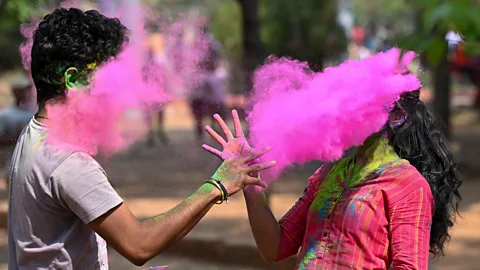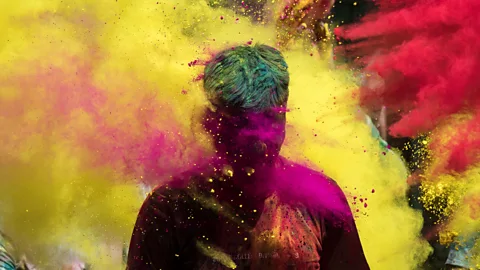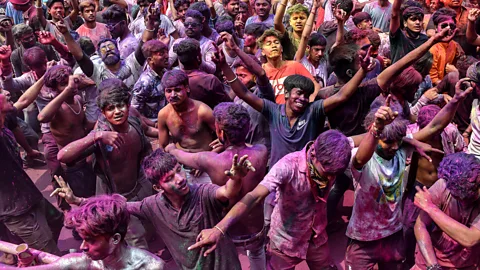How eco-conscious Gen Z are celebrating Holi in India
 Getty Images
Getty ImagesHoli represents love, new beginnings, the onset of spring and the triumph of good over evil. This year, it also marks a pivot towards eco-conscious celebrations, thanks to Gen Z in India.
One of the most iconic and culturally immersive festivals, aptly called the 'festival of colours' in the West, Holi is celebrated across India and in communities around the globe with irrepressible gusto. In India, schools shut, offices close and people flood the streets, playfully dousing each other in colour.
The festival represents many things: love, new beginnings, the onset of spring and, according to Hindu mythology, the triumph of good over evil. It typically spans two days and begins with Choti Holi or Holika Dahan on day one, when locals ignite a bonfire to dispel negativity, cleanse past sins and burn the legendary demoness Holika – and in colder regions to keep warm. The downside for the environment, however, are the numerous trees that are chopped down across India to fuel those ceremonial bonfires.
Day two of Holi is the main powder-throwing event, transforming the whole country into a vibrant spectacle. It can, however, get messy as people gather in large crowds drenching each other with scented powder, water pistols and water balloons. In addition to copious water waste, this day of Holi exposes communities to powders that often have an alarmingly high concentration of toxic chemicals, synthetic dyes and inferior-quality oil paints including heavy metals, acids, powdered glass and mica dust.
 Getty Images
Getty ImagesSolutions for a greener Holi
Gen Z, who are becoming known for their more conscientious habits as well as breaking from traditions that don't work for them, are weaving modern, innovative and eco-conscious elements into the Holi traditions. The World Economic Forum reported that Gen Z has the highest level of concern around the planet's wellbeing, influencing others to prioritise green living in their purchasing choices. This is a shift that began a few years back, with millennials swapping Holi powders for flowers or herbal colours.
But "a sustainable Holi isn't just about using organic colours", said 26-year-old sustainability blogger who goes by the name Samridhi, from Mumbai. "It's more than that – it's carpooling or taking public transport to travel around, buying local, promoting small businesses, cooking at home and opting for plastic-free goodies and gifts."
Natural and herbal colours are typically made from floral extracts, vegetable dyes and kitchen ingredients. For instance, turmeric powder for yellow, Palash petals for orange and pomegranate peel or hibiscus flowers for red. But Gen Z has a take on this millennial-led trend: "I believe in a zero-waste approach, which means not a single flower or leaf should be plucked. Instead, I collect flowers that are already donated to temples and use fruit and food scraps left from preparing snacks for our Holi parties," shared 19-year-old Priyanka Shinde from Pune.
"I stumbled upon an Instagram reel that showed how using cow dung cakes for Holi bonfires is more planet-friendly compared to traditional wooden logs," said 20-year-old Vedang Gupta from New Delhi, a city that ranks infamously low on the Air Quality Index (AQI). He explained that in addition to saving trees, burning cow dung instead also helps local cow shelters. "I found this super cool and have been [burning cow dung instead of wood] ever since," Gupta added.
Beyond green shopping
On social media, Gen Z creators are posting content that aligns with their planet-focused values, giving the Holi festival an eco-friendly makeover. "This year I'll be sharing #OOTD mirror selfies with styling tips on how to upcycle old discarded clothes into fun Holi outfits instead of buying new ones," said 22-year-old Sarah Mukherjee from Kolkata.
However, for Generation Z a true planet-friendly lifestyle goes beyond sustainable shopping, encompassing a greater philosophy of kindness and respect.
"I like to make sure that people are okay with and give their consent to applying colour on them, and I expect the same in return. You can no longer get away with things like 'bura na maano, holi hai' [a common phrase used to cajole people to not take offense if someone plays a prank or forcefully throws colour on them as a part of the festivities] like the previous generations did," explained 24-year-old Aditi Srivastava from Mumbai. Previous years' Holi festivals have included several instances of non-consensual colour splashing and unwanted attention towards women.
Similarly, during past Holi celebrations, stray animals have been splashed with colours and are often targeted – especially when they're unable to escape. This can lead to health problems and even blindness in the animals.
"It's heartbreaking to catch them hiding under cars, trying to evade hooligans throwing paints on them," said 23-year-old Sara Sing from New Delhi. Singh is a member of a local cat club that does volunteer work to rescue and foster cats as well as raise funds for their medical care. "We use festivals like Holi and Diwali to spread awareness against animal cruelty by sticking posters across our neighbourhood,” Singh added of her group.
As a pet owner herself, Singh prefers to whip up dog-friendly gujiyas (a popular empanada-like stuffed dessert made on Holi) and enjoy a quiet holiday at home. "My building security guards usually inform me if a stray animal is being forced to play Holi. I immediately run down with pet shampoos as I already have them handy. If they're not washed in time, it can lead to allergies and hair loss," she said.
 Getty Images
Getty ImagesOnline and offline alternatives
Every year after Holi, hospitals are filled with patients suffering from various health issues such as viral flu and respiratory problems. Large Holi gatherings also tend to elevate the risk of spreading infections. To combat this, Gen Zers are stepping away from boisterous colour battles and noisy street parties – turning to quieter, offbeat and tech-savvy celebrations.
In the city of Mathura, renowned for hosting one of India's grandest Holi celebrations, the holiday has come to symbolise massive processions eagerly attended by hundreds of foreign tourists each year. But 20-year-old Rajveer Saxena, a lifelong resident of Mathura, prefers to simply hop over to his building terrace with a drone and capture colourful aerial shots for his Instagram page – without even heading into the streets.
Similarly, Richa Rao, a 20-year-old undergraduate student from Mumbai, added, "My friends and I like to keep it low-key. A couple of us just catch up to create dance videos or take slow-mo shots of us tossing herbal colours."
Experiential trips are also being organised inside the Aarey Forests of Mumbai, inviting younger folks to connect with tribal communities, learn how to make festive titbits on a choola (traditional stove) in their kitchen gardens and hike around to feel at one with nature.
---
Join more than three million BBC Travel fans by liking us on Facebook, or follow us on Twitter and Instagram.
If you liked this story, sign up for The Essential List newsletter – a handpicked selection of features, videos and can't-miss news delivered to your inbox every Friday.